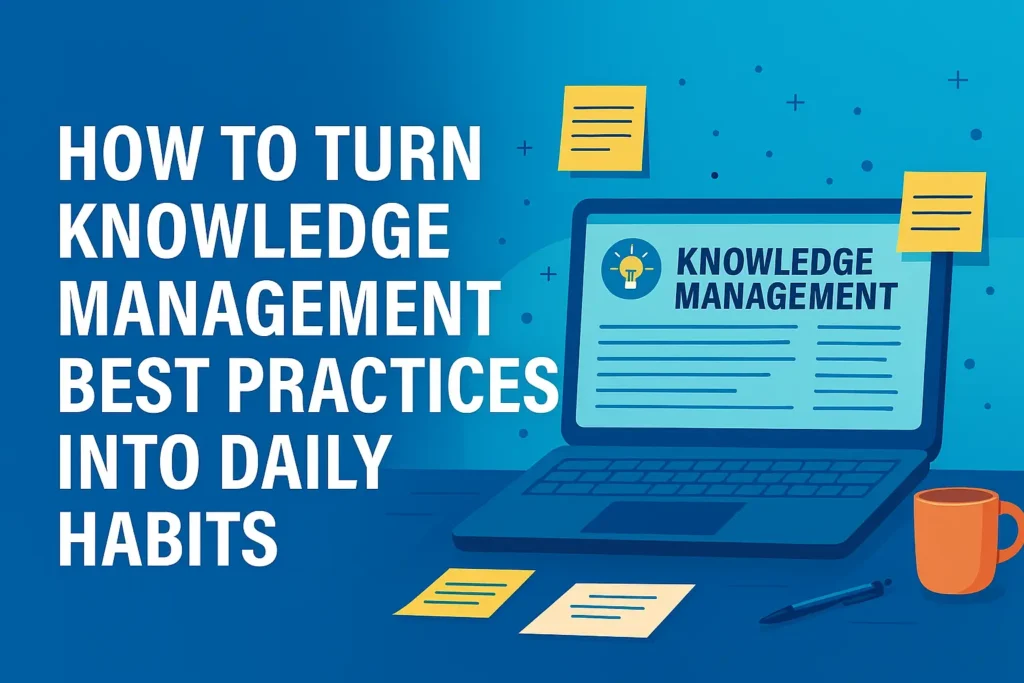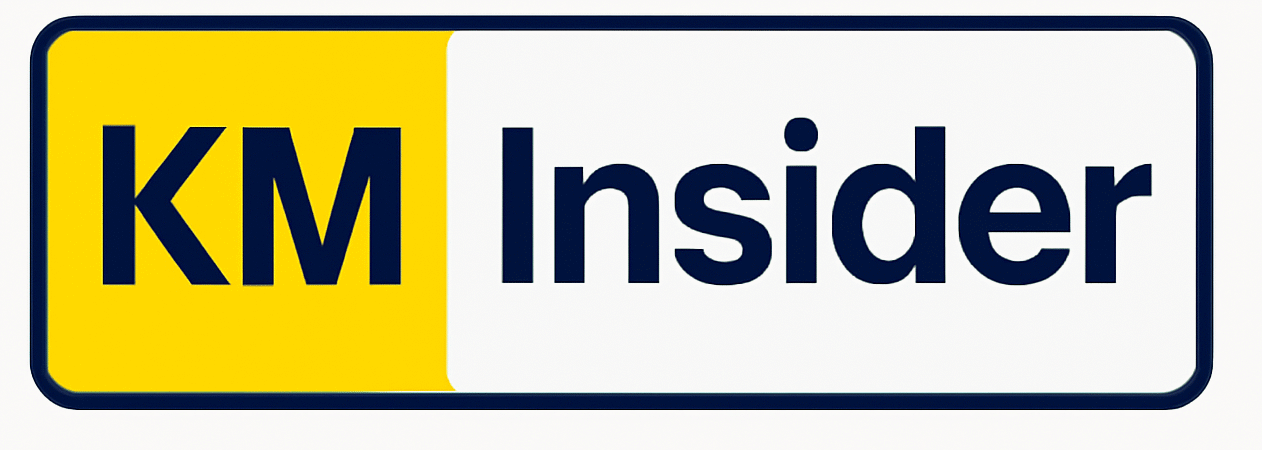Knowledge management (KM) succeeds not when it exists as a project, but when it becomes part of the everyday rhythm of how people work, share, and make decisions. Many organizations have frameworks, policies, and tools that define how knowledge should flow. Yet, in practice, much of that structure remains unused or forgotten because it never translates into habit.
The real challenge lies not in defining best practices, but in embedding them into the culture and daily behavior of every employee. Turning KM best practices into habits is what separates organizations that talk about knowledge management from those that truly live it.
This article explores how to make that transition. We’ll look at what “habitual KM” means, why most KM efforts struggle to stick, and practical steps to transform best practices into something people naturally do without being told.

Why Knowledge Management Often Fails to Stick
Many KM initiatives start with enthusiasm. There is a launch, a new platform, a communication campaign, and maybe even training sessions. But over time, enthusiasm fades. The portal is updated less frequently, communities of practice go quiet, and people return to old habits—saving files locally, repeating work, or seeking answers in email threads.
This happens for one main reason: knowledge management remains an extra task rather than part of the flow of work.
People don’t resist KM because they don’t see its value. They resist because it feels disconnected from their daily routines. Uploading lessons learned or contributing to a knowledge base feels like a separate activity rather than something embedded in the process itself.
To make KM sustainable, it must align with how people naturally think, behave, and get things done.
Habit Is the Real Backbone of KM
Think about how professionals adopt tools like email, Slack, or Teams. No one forces them to check messages daily; it has become habitual because communication is essential to their work. KM must operate the same way—becoming invisible yet indispensable.
Habits are powerful because they reduce cognitive effort. When something becomes automatic, it no longer feels like an additional task. The same psychology can transform KM from a structured system into an everyday mindset.
The key lies in moving from “KM as a framework” to “KM as a way of working.”
Step 1: Redefine KM in Terms of Daily Behavior
Before you can build habits, you need clarity on what those habits look like. Many organizations describe KM in broad terms—capture knowledge, share knowledge, reuse knowledge—but these concepts need to be translated into daily, observable actions.
Ask:
What does knowledge sharing look like in a typical day for a project manager, a software developer, or a sales executive?
For instance:
- For a project manager, it might mean recording lessons learned at the end of each sprint.
- For a sales executive, it could mean tagging CRM entries with insights from client interactions.
- For a developer, it might mean updating internal documentation immediately after a code change.
The more tangible and role-specific KM becomes, the easier it is for people to practice it habitually.
Step 2: Integrate KM into the Flow of Work
If you want people to adopt KM practices naturally, meet them where they already are. This means integrating KM directly into their daily tools and processes.
When KM requires a separate login or an extra step, it becomes optional. But when it’s part of the same workflow used for project updates, communication, or reporting, it feels natural.
Here’s what that looks like in practice:
- Embedding knowledge capture into project closure templates.
- Linking learning repositories to collaboration tools like Microsoft Teams or Slack.
- Using CRM systems that prompt users to record client insights right after meetings.
- Automating content suggestions so employees see relevant knowledge within the context of their task.
Technology should not be a separate destination for KM. It should quietly support people’s natural workflow, surfacing the right knowledge at the right time.
Step 3: Make KM Social, Not Administrative
Humans are social learners. We absorb information more effectively when it’s shared through conversation, collaboration, or storytelling rather than through rigid documentation.
Instead of focusing only on databases and repositories, organizations should nurture knowledge-sharing communities where stories, experiences, and practical lessons flow organically.
This means:
- Hosting informal “learning huddles” or knowledge cafés.
- Encouraging short storytelling sessions after major projects.
- Highlighting knowledge contributions in company newsletters or town halls.
- Recognizing employees who actively share useful insights.
When KM becomes social, it stops feeling like a chore. It becomes something people enjoy and take pride in.
Step 4: Design for Micro-Habits, Not Big Transformations
People rarely change overnight. Lasting KM adoption happens through small, consistent actions. Instead of pushing for sweeping behavior changes, design micro-habits that employees can easily repeat.
A few examples of KM micro-habits:
- Adding one learning point after every project meeting.
- Sharing one useful document or article each week.
- Commenting once a day on a knowledge thread or community post.
- Updating one section of a wiki after using it.
These small actions compound over time, creating a rhythm of knowledge exchange that becomes natural.
To help reinforce them, leaders can use behavioral nudges such as reminders, feedback loops, and visible examples of positive behavior.
Step 5: Build Emotional Connection to KM
People don’t form habits only through instruction; they form them through emotional connection. When employees see how KM directly helps them succeed, they engage naturally.
This emotional link often comes from relevance and recognition.
Relevance means employees understand how KM makes their job easier, faster, or more effective. Recognition means the organization visibly appreciates their contributions.
You can strengthen this connection by:
- Sharing success stories of teams who benefited from reusing knowledge.
- Publicly appreciating those who share lessons or insights.
- Showing real metrics, such as time saved through accessible knowledge.
When people feel that their contributions matter, habit follows motivation.
Step 6: Empower Managers as Habit Builders
Leaders and managers play a pivotal role in embedding KM habits. When a manager asks about lessons learned in every meeting, people understand that KM is not optional—it’s expected.
Managers can reinforce KM through:
- Modeling behavior, such as sharing their own insights and learnings.
- Integrating KM checkpoints into workflows, reviews, and stand-ups.
- Setting expectations for documentation and reuse during project planning.
KM habits grow faster when they are reinforced by leadership through example and gentle accountability.
Step 7: Simplify Access and Eliminate Friction
One of the most overlooked aspects of habit formation is convenience. The harder something is to do, the less likely people will do it consistently. KM platforms that require multiple clicks, logins, or approvals discourage participation.
Simplify wherever possible:
- Use single sign-on and minimal interfaces.
- Provide one unified search that spans all repositories.
- Offer quick templates for documenting lessons learned.
- Use tagging and AI tools to automate classification.
Friction kills habits. Simplicity sustains them.
Step 8: Measure Habits, Not Just Outputs
Traditional KM metrics focus on quantity—number of documents uploaded, number of users, or number of views. While useful, these do not reveal whether knowledge-sharing has truly become habitual.
To measure KM maturity, organizations need behavioral indicators.
Ask questions like:
- Are people regularly updating knowledge assets as part of their process?
- Are teams referencing past lessons in new projects?
- Are employees actively engaging in community discussions?
You can even measure consistency over time. For example, how often a department contributes to lessons learned month over month.
The goal is not to measure activity, but to measure the rhythm of knowledge behaviors across the organization.
Step 9: Create Rituals That Reinforce KM Culture
Rituals are the cultural glue that turns habits into shared identity. They signal what matters in an organization.
Simple KM rituals might include:
- A “Knowledge Friday” where teams share one thing they learned that week.
- Monthly retrospectives that always start with a review of past lessons.
- A “KM Spotlight” in town halls celebrating real-world impact stories.
These small, recurring rituals create rhythm and continuity. Over time, they normalize KM as part of the organization’s DNA.
Step 10: Make Learning from Knowledge Visible
One of the most powerful motivators is visibility. When employees can see that knowledge is being reused, adapted, or celebrated, it validates the habit.
For example:
- Publish stories showing how a project succeeded because of reused insights.
- Visualize metrics showing reduction in duplicate efforts.
- Share quotes or testimonials from teams who benefited from KM.
Visibility turns KM from a background process into a living, breathing part of organizational success.
Step 11: Align KM with Personal Growth
KM should not feel like compliance. It should feel like career acceleration. When people understand that contributing and reusing knowledge builds their expertise and credibility, their motivation becomes intrinsic.
Encourage employees to:
- Use KM contributions as evidence in performance reviews.
- Add community contributions or knowledge assets to their learning portfolio.
- Mentor others using lessons learned from previous work.
Linking KM to personal growth turns it from a system goal into a self-driven behavior.
Step 12: Reinforce with Continuous Feedback and Learning
Habits need reinforcement. People must see that their effort leads to improvement. KM systems can support this through feedback loops—showing users when their content is reused or appreciated.
Simple feedback mechanisms like notifications (“Your document was used in three new projects”) or badges recognizing helpful contributions can strengthen commitment.
Feedback transforms KM from a static repository into an active learning loop.
From Framework to Culture
Ultimately, the goal is not to have people “do KM.” It’s to have people work in a way that is knowledge-driven by default.
When best practices become habits, KM shifts from being a corporate initiative to being part of the organization’s culture. You no longer need to remind employees to document insights or share experiences—they do it naturally, because it’s how they think.
The journey takes time and persistence. But every small habit, every reinforced behavior, and every visible success story brings the organization closer to that goal.
Closing Thought
Knowledge management best practices are not about rules or repositories. They are about people—how they think, connect, and learn. The most effective KM systems are not built through technology alone, but through the daily habits that shape how knowledge lives and breathes within an organization.
When you turn KM from a process into a habit, it becomes invisible. And that’s when it truly works.
